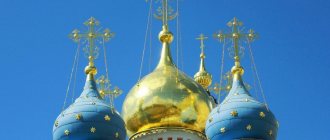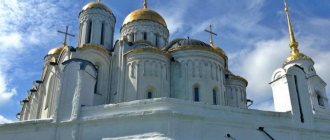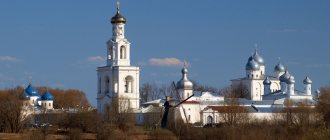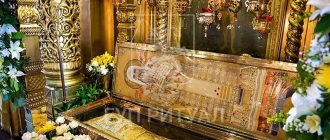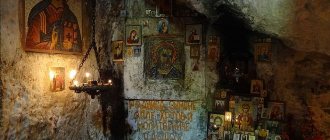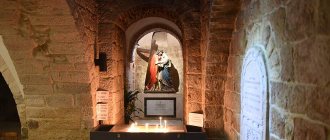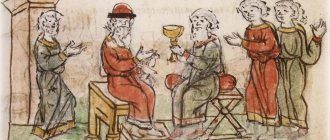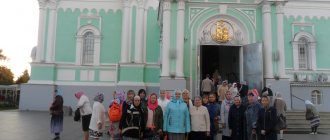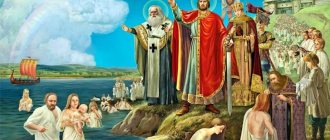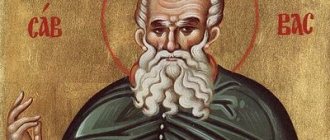Active monasteries in Crimea
Operating monasteries, annually visited by crowds of tourists and pilgrims:
- Toplovsky Convent near Feodosia, where you can plunge into the font and wash in the clean and healing waters of the nearby waterfall.
- Convent of the Holy Trinity in Simferopol, storing the relics of St. Luke.
- Annunciation Monastery, occupying Mount Mangup.
- The Holy Dormition Monastery is a cave type, located near Bakhchisarai in the Mariam-Dere area.
- Kiziltash Stefanovo Monastery near Feodosia. It is notable for being located in the protected Kiziltash gorge.
- Inkerman St. Clement Cave Monastery near Sevastopol.
- Kosmo-Damianovsky Monastery, located near Alushta, occupying the territory of the Crimean Nature Reserve.
Cave monasteries of Crimea
The Crimean peninsula is notable for its rocky terrain, replete with sheer walls, recesses and caves. Therefore, it is not surprising that many Christian shrines were built here in different centuries.
On the peninsula you can visit the following cave monasteries:
- Inkerman Monastery, the oldest of the cave monasteries, named after St. Clement. The main premises are located in caves carved into the western part of the Monastery Rock.
- Holy Dormition, built at the end of the 8th century. Walking along the road to the cave town of Chufut-Kale, you can see the abbot’s dwelling, a bell tower, a rocky excavation with the remains of attached cells, and an ancient ruined fountain.
- Chelter-Marmara near Bakhchisarai, located at an altitude of 400 m above the sea. It was built at the beginning of the 9th century as a stronghold of Greek Orthodoxy.
- Shuldan near the Sevastopol village of Ternovka, built by fugitive Byzantine monks at the end of the 8th century. It has a two-tier structure, includes 2 temples and 20 annexes.
- Medieval Chelter Coba on Cape I-Tudor.
City of Doros (Theodoro)
The mountain called Mangup is also unusually rich in historical and religious monuments. The most ancient archaeological finds date back to the Eneolithic era. As early as the third century AD, settlements were located here, already fortified. Then the population just arrived. In the fifth century, during the reign of Justinian I, a fortress was erected here and the city of Doros was founded. In the vicinity was the country of Dori. In the tenth century the city fell into decline. Scientists attribute this to the earthquake that occurred during that period. Then the country around and the city itself were called Theodoro.
Also interesting here is the cave monastery complex. It looks like a grotto, with cells and a temple on different sides. There, on Cape Teshkli-Burun, is the Citadel of the Mungup princes, and behind it the octagonal temple. Later the Turks turned it into a mosque. There are also the Church of St. George and the Cathedral of St. Constantine nearby. Scientists suggest that they existed until the seventeenth century. The Ottomans rebuilt and renamed the city. Until the end of the eighteenth century, a Karaite community lived here. Regardless of who occupies the caves located on the territory of the peninsula, one thing can undoubtedly be said: these are the holy places of Crimea.
Toplovsky Monastery in Crimea
Toplovsky St. Paraskevinsky Monastery, opened in September 1864, is located in the picturesque river valley Mokryi Indol in the forested mountains 5 km from Feodosia. Before the founding of the monastery, the Bulgarian hermit Konstantina lived in this place, and with her several other women.
They became the first inhabitants of the monastery. Konstantina became a nun and took the name Paraskeva. Before the opening of the monastery, a small church of St. Paraskeva was built. And the nearby source was consecrated in 1863 on the day of remembrance of the saint (July 26).
Holy Dormition Monastery
The ancient men's monastery, located near Bakhchisarai, surrounded by 140-meter steep cliffs, is surrounded by many legends and is marked by the miracle of the appearance of the icon of the Virgin Mary. Russian emperors Alexander II and Nicholas I visited here.
And during the Crimean War, the monastery territory was occupied by a hospital, where the famous surgeon Pirogov worked.
Foros. Church of the Ascension of Christ
This church is the pearl of the southern coast of Crimea. It was erected by A. Kuznetsov in the nineteenth century. The church was erected on the cliff of Mount Krasnaya. The height above sea level is more than 400 meters.
The church itself survived many disasters: fire, destruction during the war, and with the advent of Soviet power, the church was looted. But having survived all the difficulties, the temple was restored in the 90s.
You can get there from any place in Crimea by car or bus. If you are traveling by public transport, you need to get off at the Sevastopol-Yalta highway ( Foros stop ) and go up the winding road to the temple. From the village of Foro you can take a taxi.
St. George's Monastery
The monastery was founded in 891 by Greek sailors. Caught by surprise by a hurricane near Fiolent, they began to pray to St. George so that their ship would not hit the rocks. The hurricane subsided, and the sailors who landed found the icon of St. George the Victorious on the shore. As a sign of gratitude to the saint, they built a cave church on a rocky slope, and placed a cross on the top of the rock.
In the Middle Ages, the monastery achieved prosperity and remained active even during the period of the Crimean Khanate. When the peninsula became part of the Russian Empire in 179, the Greek monks left the monastery, not wanting to leave the subordination of the Church of Constantinople. And the monastery became part of the Russian Orthodox Church.
Holy Trinity Monastery
Previously, on the site of the monastery there was a Greek church founded in 1796. The wooden structure fell into disrepair, and in 1868 the large Holy Trinity Cathedral was erected. The structure, made in the classical style, is beautiful and noticeable: the central part is occupied by a drum with eight sides, a bell tower rises to the left, the facade is decorated with ornaments and mosaics, and there are carved crosses on the domes.
The two main shrines of the monastery are the relics of Luke of Crimea and the icon of the Mother of God of Sorrows. The latter suddenly began to look newer in 1998.
The place of the sermon of St. Andrew the First-Called and the baptism of Prince Vladimir
Photo Alex Malev/Flickr/CC BY-SA 2.0
On the outskirts of Sevastopol are the ruins of the ancient Greek city-state of Chersonesos. Today it is one of the most significant ancient monuments in the world and ranks with the Egyptian pyramids, the Roman Colosseum and other wonders of the world.
Chersonesos was founded in the 5th century BC. The first followers of Christianity appeared here already in the 1st century. According to legend, the path of the Apostle Andrew the First-Called to Scythia, to the place of his ministry, passed through Chersonesos. At the beginning of the 4th century, seven missionary bishops were sent here to establish Christianity: five of them were brutally killed by local pagans. In memory of the seven Chersonese martyrs, a temple was erected here.
By the end of the century, Chersonesos became the Christian center of Crimea, and soon became part of the Byzantine Empire. And it was here in 988, according to the Tale of Bygone Years, in the temple “in the middle of the city, where the Korsun people gather for bargaining,” that one of the key events in history took place - Prince Vladimir received Holy Baptism. Now the Vladimir Cathedral stands at the supposed site of his baptism.
Over the course of two thousand years of its existence, Chersonese had to wage continuous wars, and already in the 16th century, only ruins remained on the site of the once rich and glorious Greek city.
Today Chersonesos is a national museum-reserve and the largest site of archaeological work on the Black Sea coast. Here you can see the ruins of an ancient theater, many temples, towers and walls, as well as all kinds of objects used by the inhabitants of Chersonesos. By the way, the most valuable of them are in the Hermitage (St. Petersburg) and in the State Historical Museum and the State Museum of Fine Arts. A. S. Pushkina (Moscow).
Relics of Luka Krymsky
In the Holy Trinity Cathedral, in a silver shrine, donated in 2001 by Greek priests, rest the relics of St. Luke of Crimea (in the world of Voino-Yasenetsky). This amazing man, a surgeon by profession, an archbishop who served in the cathedral from 1946 to 1961, experienced many troubles, was persecuted and despised. He lost his wife early and was sent into exile beyond the Arctic Circle. But he retained Christian charity and saved many people from death on the surgical table.
There is a museum of St. Luke on the monastery territory. Pilgrims from all over the country come to the relics to ask for help from the saint. And there are many known cases of healing of parishioners. Every Friday during the prayer service one is allowed to venerate the relics.
Holy springs in Crimea
In the mountainous areas of Crimea there are many holy springs, near which churches and monasteries were built. Pilgrims are drawn to these places by the opportunity to be healed with clean water.
Of the most visited Crimean springs, it should be noted:
- The source of Kosma and Damian, also called Savlukh-Su (water of health), is located in the western part of Mount Chatyrdag. Named after the brothers who lived in this place and healed people. The healing properties of water have been discovered by scientists: it is rich in potassium, manganese, lithium, magnesium and even silver.
- The source of St. Paraskeva is located near the monastery of the same name. According to local beliefs, in the place where the spring flows, the saint suffered martyrdom and lost her head. Healing water helps with eye and other diseases.
- The source of Stefan Sourozhsky is located in the picturesque area of Kiziltash, above which red rocks rise. In one of the caves there flows a spring, which was given the name of the saint. Water helps with nervous disorders, vision and hearing problems. Below the slope there is a swamp, the mud of which is also healing and relieves pain in the joints.
- The source of John the Lenten in Balaklava began to flow several centuries ago on September 11 (this is the day of the beheading of John the Baptist). In 1848, the church of this saint was erected above it.
- The source of Anastasia the Pattern Maker flows in a grotto in the rocks of Kachi-Kalyon near Bakhchisaray. The ceiling of the grotto, reaching a height of 40 m, looks like a temple dome. Every year on December 22 (the day of remembrance of the holy martyr), a church minister blesses the water in the font.
It seems that the warm Crimean air is saturated with the spirit of Christianity. There are a large number of shrines here, when approaching them you feel a feeling of grace. Every believer should definitely make a trip to Crimea and visit Christian sights.
Church in the name of Saints Constantine and Helen. Alexander Nevsky Cathedral
When visiting the Holy Places of Crimea, you can remember other churches that are located in Simferopol. For example, the church in the name of Saints Constantine and Helen. It was opened in a house that was bought by the commander of the Russian troops from a Crimean Tatar. The entire time Russian troops were quartered there, the church was working. What is interesting is that the temple’s architecture is completely different from others. They say that Catherine II, who visited Crimea at that time, prayed here. Apparently this is what gave her the idea of building the Alexander Nevsky Cathedral. This is another interesting place in Crimea. The temple was built only in 1829. It served for exactly one hundred years, after which it, like many churches of Soviet times, was closed. In nineteen thirty, it was blown up and a park was built in its place. Only at the beginning of the twenty-first century did construction begin to restore it. Currently, the temple is almost finished.
